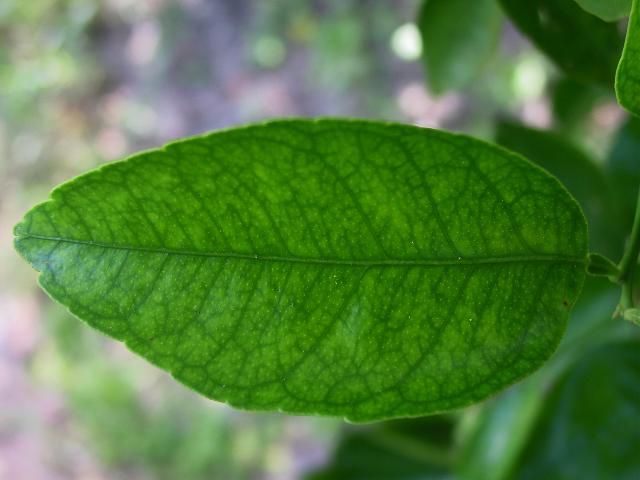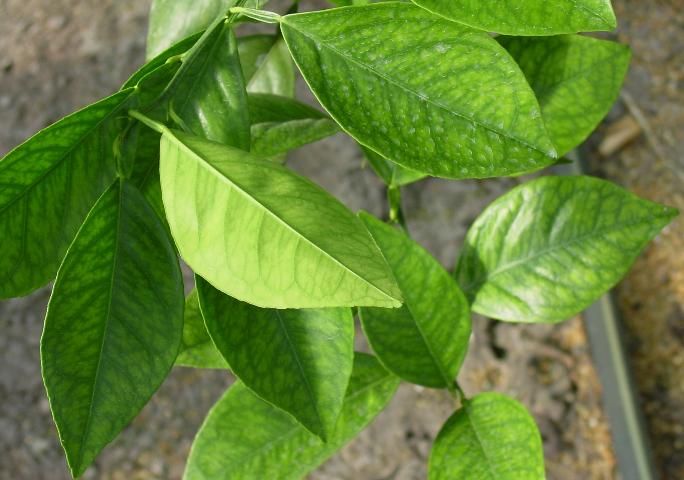This publication is part of a series about understanding nutrient requirements for citrus trees. For the rest of the series, visit https://edis.ifas.ufl.edu/topic_series_citrus_tree_nutrients.
To maintain a viable citrus industry, Florida growers must consistently and economically produce large, high-quality fruit crops year after year. Efficiently producing maximum yields of high-quality fruit is difficult without understanding soil and nutrient requirements of bearing citrus trees. Most Florida citrus is grown on soils inherently low in fertility with low-cation exchange capacity (CEC) and low water-holding capacity; thus, soils are unable to retain sufficient quantities of available plant nutrients against leaching caused by rainfall or excessive irrigation.
Seventeen elements are considered necessary for the growth of green plants:
- Carbon (C)
- Hydrogen (H)
- Oxygen (O)
- Nitrogen (N)
- Phosphorus (P)
- Potassium (K)
- Magnesium (Mg)
- Calcium (Ca)
- Sulfur (S)
- Manganese (Mn)
- Zinc (Zn)
- Iron (Fe)
- Copper (Cu)
- Boron (B)
- Chlorine (Cl)
- Molybdenum (Mo)
- Nickel (Ni)
Plants obtain C, H, and O from carbon dioxide and water. The remaining elements, which are called the "mineral nutrients," are obtained from the soil. Mineral nutrients are classified as macronutrients and micronutrients. The term "macronutrients" refers to the elements that plants require in large amounts (N, P, K, Mg, Ca, and S). The term "micronutrients" applies to plant nutrients that are essential to plants but are needed only in small amounts (Mn, Zn, Fe, Cu, B, Cl, Mo, and Ni).
When macronutrients are supplied in relatively higher proportions than micronutrients for growth stimulation of newly planted citrus trees, extreme depletion of micronutrients can develop as a result of marked top growth, and micronutrient deficiencies can appear. Therefore, a balance between macronutrients and micronutrients is needed. Citrus micronutrient deficiencies are most commonly observed on previously uncultivated soils, shallow soils with high water table, extremely sandy areas, and calcareous soils.
Since mineral nutrition is a major factor in maximizing yield of high-quality fruit, understanding the functions of mineral elements, diagnosing nutrient deficiencies, and providing needed fertilizers are essential. This publication describes and discusses manganese (Mn) and zinc (Zn) deficiencies, functions, and recommended practices to alleviate nutritional problems.
Introduction
Meeting the world's escalating food needs cannot be achieved without fertilizer input. Without fertilizer, the world would produce only about half as much food, and more forested and marginal lands would have to be put into production. Inorganic commercial fertilizer plays a critical role in the world's food security, and it is important from both yield and food quality perspectives. Intensifying production and increasing yield on limited arable land secure a sufficient food supply, and fertilizer plays a critical role in these goals. Intensifying production is increasingly essential to meet the challenge of future food demands. However, this intensification must be done while also minimizing environmental impacts. The 4R Nutrient Stewardship Framework (i.e., right fertilizer source, right rate, right time, and right place) is therefore very important.
Manganese and Zinc Deficiencies
Manganese deficiency occurs commonly in Florida and in many other areas of the world. It is particularly evident in the spring after a cold winter. Recognizing Mn deficiency symptoms can be delayed due to masking by severe Zn or iron (Fe) deficiencies. Sometimes, the deficiency can be confused with symptoms of Fe and Zn deficiency or boron (B) toxicity. Manganese deficiency leads to a chlorosis in the interveinal tissue of leaves, but the veins remain dark green (Figure 1). Young leaves commonly show a fine pattern or network of green veins on a lighter green background but the pattern is not as distinct as with Zn or Fe deficiencies because the leaf is greener (Figure 2). By the time the leaves reach full size, the pattern becomes more distinct as a band of green along the midrib and principal lateral veins, with light green areas between the veins.

Credit: Mongi Zekri, UF/IFAS

Credit: Mongi Zekri, UF/IFAS
In more severe cases, the color of the leaf becomes dull green or yellowish-green along the midrib and main lateral veins, and it becomes pale and dull in the interveinal areas. White opaque spots may develop in the interveins, which give the leaf a whitish or gray appearance. The leaves are not reduced in size or changed in shape by Mn deficiency, but affected leaves prematurely fall from the tree. No particular twig symptoms are related to Mn deficiency. Growth is reduced in an acutely affected tree, giving it a weak appearance.
Manganese deficiency may greatly reduce crop volume and fruit color. The fruit may become smaller and softer than normal, and the rind may become pale in color. Manganese deficiency is frequently associated with Zn deficiency. A combination of the two deficiency symptoms on leaves is called "marl frenching" or "marl chlorosis," which is characterized by dark green veins with dull white and green areas between the veins. In such combinations, the Mn deficiency is acute, and the Zn deficiency is relatively mild.
Due to leaching in the acid soils and to insolubility in the alkaline soils, Mn deficiency occurs on both acidic and alkaline soils in Florida. It can be associated with deficiencies of Zn, Fe, and copper (Cu) on both acid and alkaline soil and with magnesium (Mg) deficiency on acidic sandy soils.
Zinc deficiency has traditionally been the most widespread nutrient deficiency in citrus. Zinc deficiency is commonly known as "rosette" or "frenching" in Florida. Rosetting does not usually occur in citrus. Zinc deficiency symptoms are characterized by irregular green bands along the midrib and main veins on a yellow background (Figure 3). The relative amounts of green and yellow tissue vary from a condition of mild Zn deficiency in which only small yellow patches between the larger lateral veins are present to a condition in which only a basal portion of the midrib is green and the remainder of the leaf is light yellow to white (Figure 4). In less acute stages, the leaves are almost normal in size, while in severe cases the leaves are pointed, abnormally narrow with the tendency to stand upright, and extremely reduced in size.

Credit: Mongi Zekri, UF/IFAS

Credit: Mongi Zekri, UF/IFAS
In mild cases, Zn deficiency symptoms appear on weak twigs. Fruit formed on these twigs are drastically reduced in size and have an unusually smooth and light-colored thin skin and very low juice content. As Zn deficiency progresses, leaves are affected across the entire periphery of the tree, and twigs become thin and die back rapidly. A profuse development of "water sprouts" occurs on the main branches and trunk with leaves free of deficiency symptoms. Fruit grown on these water sprouts are large, coarse, and woody.
The tree has dense growth in the center and a dying appearance across its periphery, which gives the tree a very bushy appearance. Affected leaves have irregular chlorotic areas between the leaf veins. As they develop, new leaves become progressively smaller. The number of blossoms and the fruit set is greatly reduced, and fruit produced have poor quality. Zinc deficiency symptoms can be so severe that they may mask or noticeably alter the symptoms of other deficiencies or disorders.
Deficiencies of Mg and Cu can also reduce Zn uptake through root injury, giving rise to characteristic symptoms of Zn deficiency, even though sufficient Zn is available in the soil. Zinc deficiency can develop due to soil depletion or formation of insoluble Zn compounds. Excessive phosphorus or nitrogen can also induce or aggravate Zn deficiency. Soils receiving large and frequent amounts of poultry manure often show Zn deficiency symptoms.
Functions of Mn
- Involved in the production of amino acids and proteins
- An activator of several enzymes
- Plays an essential role in respiration and nitrogen metabolism
- Necessary for the reduction of nitrate; helps make nitrate usable by plants
- Plays a role in photosynthesis and in the formation of chlorophyll
Functions of Zn
- Involved in plant carbon metabolism
- A necessary component of several enzyme systems that regulate various metabolic activities within plants
- Part of an enzyme that regulates the equilibrium among carbon dioxide, water, and carbonic acid
- Part of two enzymes that play a role in protein metabolism
- Essential for the formation of chlorophyll and function of normal photosynthesis
- Needed to form auxins, which are growth-promoting substances in plants
- Associated with water relations in plants; improves water uptake
Fertilizer Sources and Formulations for Soil Application
Manganese
Manganese sulfate
Manganese oxysulfate
Manganese oxide
Zinc
Zinc sulfate
Zinc oxide
Zinc EDTA and HEDTA
Recommended Rates and Timing
Manganese. The behavior of Mn in the soil is similar to that of Zn especially with respect to relative availability in acidic and alkaline soils. Either sulfate, oxysulfate, or some oxide forms of Mn can be used to correct Mn deficiency with the degree of effectiveness decreasing in that order. Soil application of Mn is not recommended on calcareous or alkaline soils where Mn deficiency is commonly encountered.
For groves on acidic soils that show persistent Mn deficiency symptoms on young foliage, Mn can be included in fertilizer applied to the soil. Soil application of 7–10 lb. of Mn as MnSO4 per acre is recommended. On calcareous or heavily limed acid soils, foliar application of 3–5 lb. of Mn per acre, applied to two-thirds to fully expanded spring or summer flush leaves, is recommended. If nitrogen is needed, adding 7–10 lb. per acre of low biuret urea will increase foliar Mn uptake.
Foliar spray application quickly clears up the deficiency pattern on young leaves, but older leaves respond less rapidly and less completely. When Mn is sprayed on Mn-deficient citrus trees, fruit yield, total soluble solids in the juice, and pounds solids per box of fruit will certainly increase. A special effort to prevent Mn deficiency symptoms should be made in groves being visually monitored for citrus greening disease symptoms.
Zinc. Soil pH is the most important factor regulating plant-available Zn. Zinc precipitates at alkaline pH, markedly decreasing availability. A soil pH less than 6.5 is the preferred situation. Although there are natural mechanisms in the soil-plant system that may increase the availability of Zn in alkaline soils, Zn deficiencies are common. Special consideration should be given to groves being visually monitored for citrus greening disease symptoms. Trees on Carrizo citrange rootstock tend to show Zn deficiency symptoms more readily than other rootstocks.
Application of foliar Zn fertilizer is usually combined with other micronutrients and with pesticide sprays scheduled in late spring, summer, or fall at 3–5 lbs. of metallic Zn/acre using ZnSO4, Zn(NO3)2, or ZnO. A number of other formulations are available for foliar application, including organically chelated forms using lignin sulfonate, glucoheptonate, or alpha-keto acids. Under severe deficiency or persistent deficiency symptom conditions, a foliar Zn spray may be necessary on each major growth flush to keep the trees free of symptoms because Zn does not translocate readily to successive growth flushes. Maximum benefit is obtained if spray is applied to young leaves when they are two-thirds to nearly fully expanded, before hardening off.
Although practically speaking, Zn dusts are less effective than sprays, inorganic and organic Zn fertilizer sources are about equally effective with respect to foliar absorption. Application of Zn directly to acidic soils is rarely an economic or an effective practice, because of the massive rates required to correct a deficiency. Zinc should not be soil-applied to groves on calcareous soils, because the alkaline pH renders the Zn unavailable almost immediately.
Conclusion
Supplying sufficient nutrition should be a high-priority management practice for every grower. An appropriate nutrient balance using fertilizer management is necessary to achieve sufficient plant nutrition for best fruit yield and quality. If an element is below the critical level, yield production will fall—even though the other elements are kept in good supply. Balanced use of plant nutrients corrects nutrient deficiencies and toxicities; improves soil fertility; increases nutrient- and water-use efficiency; enhances crop yields and fruit quality; develops tree tolerance to pests, diseases, and other stresses; and improves environmental quality.